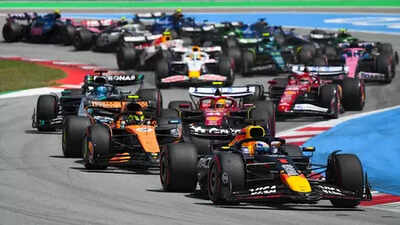Want to work in Formula 1? 8 job roles that can land you a six-figure package - Times of India

Formula 1 in 2025 looks vastly different from the V8-fuelled chaos of the early 2000s. With the hybrid era now fully matured and sustainability mandates reshaping how teams operate, F1 has evolved into one of the most technically advanced, commercially aggressive and globally relevant motorsports today.It’s no longer enough to track lap times or understand tyre compounds. To keep up with F1 now requires fluency in analytics, aerodynamics, AI-assisted race strategy and global fan economics. That shift has opened doors to a new generation of professionals, many of whom don’t come from the traditional paddock system but offer the expertise teams can no longer do without.While drivers remain the face of the sport, the highest-paid and most influential roles are now increasingly found off the track.
Teams are expanding their data and performance divisions, investing in advanced materials and building in-house media operations to connect with a digitally native fanbase.The result? Careers in F1 are more accessible than ever. Whether your background is in engineering, content, data science, or commercial strategy, there is a place on the grid for professionals ready to meet the sport’s evolving demands. Here’s a look at some of the most impactful and high-paying roles shaping F1’s future.
Think of a race engineer as the driver’s second brain. From the first practice session to the chequered flag, they interpret car feedback, adjust setups and make crucial decisions in real time.Most race engineers rise through internal performance departments after working in areas like telemetry analysis, simulator sessions or testing. It’s among the most competitive jobs in motorsport and also one of the most well-compensated, given the direct impact on race results.
In a sport where marginal gains define outcomes, the aerodynamics department is a major performance driver. Engineers in this role use CFD simulations, wind tunnel tests, and flow visualisation to optimise airflow across the chassis and wings.With ground-effect regulations back in focus since 2022, the challenge in 2025 is to generate maximum downforce while reducing drag, all within cost and sustainability regulations.
This role blends creative design thinking with complex physics and is crucial for competitive car development.
Strategy analysts operate like high-speed chess players. They simulate a wide range of race-day scenarios, from undercuts and overcuts to virtual safety car timing, using data modelling and increasingly, machine learning.Their core responsibilities include analysing competitors, tracking tyre degradation and identifying optimal pit windows.
A background in data science, game theory, or operations research is often preferred. As F1 strategy becomes more software-led, this role continues to attract top analytical minds from outside motorsport as well.
Modern F1 power units are technical masterpieces. Engineers in this space manage hybrid turbo systems, energy recovery modules, battery performance and sustainable fuel integration.With the 2026 regulations around the corner, the focus is now on balancing thermal efficiency and electrical deployment while maintaining reliability.
Professionals with experience in thermodynamics, control systems and electrical integration are especially valuable in this domain.
Unlike strategists who focus on race scenarios, performance analysts focus on the car’s internal behaviour. They dive into telemetry, tyre data and energy systems to assess how different components impact pace and stability.These analysts work across the race weekend, validating upgrades, running simulations and informing setup decisions.
The role demands a strong foundation in motorsport or mechanical engineering, along with proficiency in data analysis tools and simulation software.
Carbon fibre may not dominate headlines, but it forms the backbone of every F1 car. Composite engineers are responsible for designing and validating parts such as the monocoque, crash structures, wings, and floor panels.This role demands expertise in CAD, finite element analysis and material science.
Engineers must balance weight, strength, and flexibility, often working within tight FIA regulations. As teams explore sustainable and recyclable materials, composite engineering is becoming more innovative and future-facing.
F1’s commercial side has grown exponentially, particularly with Liberty Media’s global expansion strategy. Commercial managers work closely with brands across sectors including luxury, tech, energy and finance to create high-value sponsorship deals and activations.These professionals oversee contracts, build brand alignment strategies and ensure visibility across broadcasts and digital content. A strong grasp of international markets, brand storytelling, and ROI-driven campaign planning is essential. It is one of the few non-technical roles where salaries rival those in engineering.
F1 has become as much a media product as a sport. Every team now runs a full-scale content operation, publishing behind-the-scenes videos, interviews, race-day recaps and social-first campaigns.Content producers coordinate shoots, write scripts, oversee post-production and optimise content for online platforms. The role suits creative professionals who understand both storytelling and the rhythm of race weekends. It has also become a key entry point for young talent looking to break into motorsport media.
Indian professionals are no longer limited to watching the sport. Several Formula Student teams from universities like VIT, BITS Pilani, and Manipal are competing at international events such as FS UK and FS Germany.
These student teams actually mirror the structure of F1, offering valuable, hands-on experience in engineering, strategy and media.Graduates from India are also securing seats at specialised master's programmes in Cranfield, Oxford Brookes and Monash, institutions that maintain close industry ties with F1 suppliers and teams. These programmes offer a direct pipeline into technical and analytical roles within the sport.On the content side, Indian creatives and editors are contributing to the sport’s growing regional presence through remote media production, fan engagement campaigns and social storytelling. As Formula 1 eyes a potential return to India, professionals who understand both the domestic audience and the global nature of the sport will be in high demand, particularly across digital strategy, commercial outreach and brand localisation.
Careers in Formula 1 are no longer limited to engineers in the garage or mechanics in the pit lane. The modern F1 ecosystem values professionals who can think fast, adapt across disciplines and deliver under pressure.
Whether you’re building simulation models, negotiating sponsor deals, or producing viral race-day content, the goal is the same, to push performance both on and off the track and now, with more entry points and diverse roles than ever before, the opportunity to turn your skills into a high-impact motorsport career is firmly within reach. So what are you waiting for? “It’s lights out and away we go”.










_w=1200_h=630_pjpg.jpg?v=20230522122229)